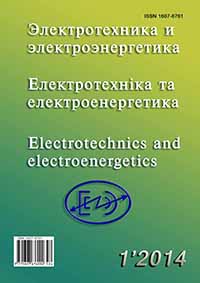POWER SYSTEM OF THE FUTURE. THE CONCEPT OF SMART GRID. SPECIFICITY OF REALIZATION IN UKRAINE
DOI:
https://doi.org/10.15588/1607-6761-2014-1-11Keywords:
intellectual electrical power system, physical model, renewable energy sources, the conception of Smart Grid, educational scientific center «Smart Grid – DonNTU»Abstract
Work is dedicated to a perspective of electrical power systems creation of the future. All modern strategic directions of generation sources development of the electrical power and power supply systems as a whole are in details considered. Special item in work is allocated to power supply systems of the Smart Grid conception with a big share of renewable energy sources, and also specificity of their realization in Ukraine. The project of educational scientific center «Smart Grid – DonNTU» constructed in Donetsk National Technical University in which the physical model of an «intellectual» power system is realized is considered. The power part of «Smart Grid – DonNTU» laboratory represents block structure in which in the blocks form such models are realized: physical model of a thermal power plant, a real solar power plant, wind turbines models, energy stores, reactive power compensators. The special bench for detailed studying of modern digital relay protection of the SiprotecTM series of Siemens® production is also realized. The physical model of the condensation turbine of a thermal power plant, and also models of wind-generating installations are executed by means of induction electrical motors with the short-circuited rotor, established on one shaft with generators of AC current. The solar power plant realized in laboratory, represents fifty five modern solar panels of the Ukrainian production with a total power of 10 kW. As model of hydrogen installation with hydrogen fuel cells in the project was accepted the educational station «Nexa® Lernsystem» with a rated power of 1,2 kW was created. This installation is equipped with necessary monitoring and optimization systems, and also built-in system of power management. At creation of laboratory installation the principle of maintenance in node constant value of reactive power due to use of dynamical reactive power compensators that will allow providing the maximum speed of the compensator is assumed as a basis and to increase its efficiency. By means of the PROFIBUS data bus all elements of physical model is integrated into the general control system of laboratory. In total this laboratory allows to model physically different normal, abnormal and emergency conditions of power supply systems of the Smart Grid conception workReferences
Сибикин Ю. Д. Нетрадиционные и возобновляемые источники энергии: учебное пособие / Ю. Д. Сибикин, М. Ю. Сибикин. – М. : КНОРУС, 2010. – 232 с.
Стычинский З. А. Возобновляемые источники энергии: Теоретические основы, технологии, технические характеристики, экономика / З. А. Стычинский, Н. И.
Воропай. – Magdeburg: Издательство Магдебургского университета имени Отто-фон-Герике (Otto-von-Guericke-Universit t Magdeburg). docupoint GmbH, 2010. – 209 с.
Официальный сайт международного проекта ITER (International Thermonuclear Experimental Reactor). Режим доступа: http://www.iter.org
Стогній Б. С. Інтелектуальні електричні мережі електроенергетичних систем та їхнє технологічне забезпечення / Б. С. Стогній, О. В. Кириленко, С. П. Денисюк // Технічна електродинаміка. – 2010. – № 6. – С. 44–50.
Официальный сайт компании Siemens® (Сименс) Smart Grid. Режим доступа: http://w3.siemens.com/smartgrid/global/en/Pages/Default.aspx
Официальный сайт агентства по возобновляемой энергетике. Режим доступа: http://www.rea.org.ua
Официальный сайт Информационно-аналитического портала «Империя». Демонтаж АЭС обойдется Германии в десятки миллиардов евро. http://www.imperiya.by/news.html
Официальный сайт Deutsche Welle. Германия произвела четверть электроэнергии из возобновляемых источников. Режим доступа: http://www.dw.de
Khan R. H. Wide area PMU communication over a WiMAX network in the smart grid / R.H. Khan, J.Y.Khan / Proceedings of Smart Grid Communications (SmartGridComm) IEEE Third International Conference. – 2012. – P. 187–192.
Официальный сайт программы финансирования альтернативной энергетики в Украине (USELF). Режим доступа: http://www.uself.com.ua/
Информационный портал ЛІГА.net. Интеллектуальные сети Smart Grid: экспертное мнение. Режим доступа: http://blog.liga.net/user/epopova/article/6447.aspx
Официальный сайт научно-учебного центра «Smart Grid–ДонНТУ». Режим доступа: http://smartgrid.donntu.edu.ua
Официальный сайт ПАО «Квазар». Режим доступа: http://www.kvazar.com/
Международный информационный научный портал «Водород». Режим доступа: http://www.hydrogen.ru
Газета о пассажирском транспорте «Омнибус». Гибридные, красивые, экономичные. Режим доступа: http://www.omnibus.ru/zarubezhe/zarubezhe14
Левшов А. В. О математическом моделировании фотоэлектрических модулей / А. В. Левшов, А. Ю. Федоров // Наукові праці Донецького національного технічного університету. Серія «Електротехніка та енергетика». – Донецьк : ДВНЗ «ДонНТУ», 2013. – № 1 (14). – С. 153–158.
Downloads
How to Cite
Issue
Section
License
Copyright (c) 2017 S. N. Tkachenko

This work is licensed under a Creative Commons Attribution 4.0 International License.
Creative Commons Licensing Notifications in the Copyright Notices
Authors who publish with this journal agree to the following terms:
Authors retain copyright and grant the journal right of first publication with the work simultaneously licensed under aCreative Commons Attribution License that allows others to share the work with an acknowledgement of the work's authorship and initial publication in this journal.
Authors are able to enter into separate, additional contractual arrangements for the non-exclusive distribution of the journal's published version of the work (e.g., post it to an institutional repository or publish it in a book), with an acknowledgement of its initial publication in this journal.
Authors are permitted and encouraged to post their work online (e.g., in institutional repositories or on their website) prior to and during the submission process, as it can lead to productive exchanges, as well as earlier and greater citation of published work.

